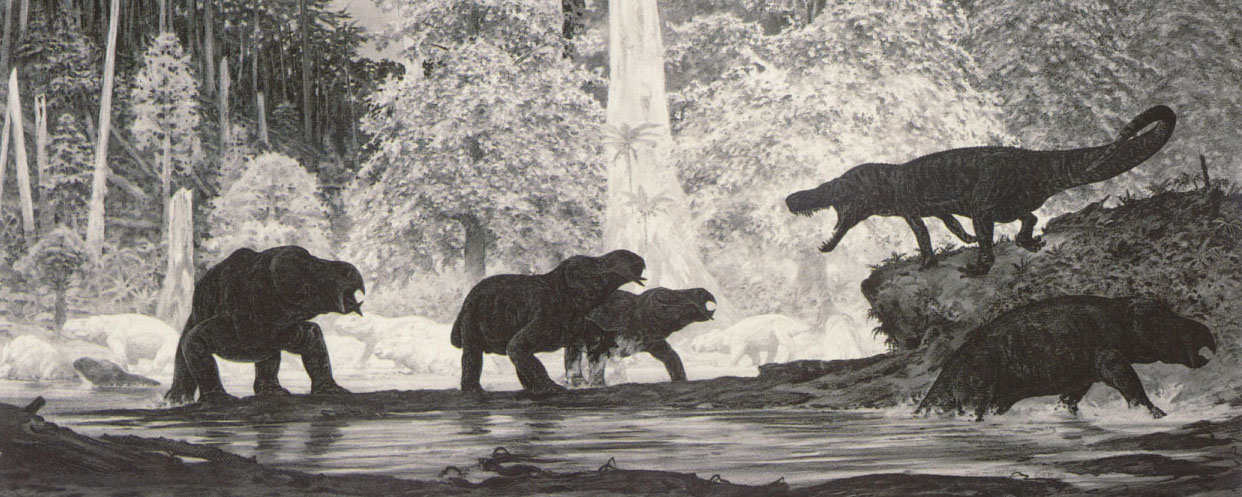

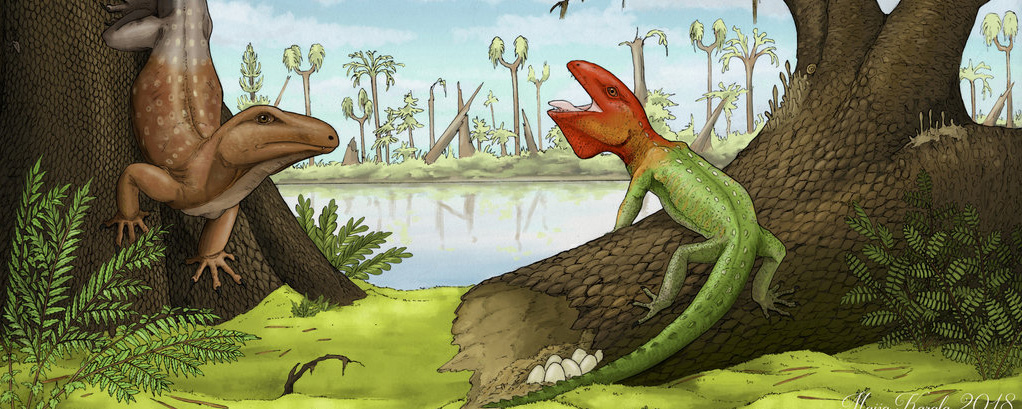
Key Points:
•Life emerged in the water, and it took a series of adaptations (defense against gravity and desiccation; new forms of respiration, reproduction, locomotion, and senses; etc.) for taxa to colonize the land.
•Among vertebrates, it was "amphibian"-grade tetrapods which partially made the transition to life on land, but only the amniotes that lived their entire life cycle on land.
•The amniotes had evolved a shelled egg, keratinized skin, and claws (among other traits) which allowed them to be successful at living on land.
•Different groups of amniotes radiated at different times: the first group were the basal members of the Synapsida (the lineage that contains mammals) in the Carboniferous and Early Permian; followed by their descendants (the Therapsida) in the Middle and Late Permian; then the Pseudosuchia (crocodile-line archosaurs) in the Triassic.
•Within Amniota (the terrestrial vertebrates with a shelled egg), dinosaurs are nested with the increasingly exclusive groups Sauropsida, Diapsida, Sauria, Archosauromorpha, Archosauriformes, Archosauria, Avemetatarsalia, Ornithodira, Dinosauromorpha, and Dinosauriformes.
I. Dinosaurs Among the Vertebrates
Dinosaurs are, obviously, animals. But what kind of animal are they?
Dinosaurs are vertebrates: they have an internal skeleton; a dorsally-located neural chord; skulls with eyes, nasal capsules, ear chambers, and brains; and many other traits shared with lampreys & hagfish, sharks & their kin, ray-finned fish, coelacanths, lungfish, and the terrestrial vertebrates. They are furthermore gnathostomes (vertebrates with jaws and teeth), osteichthyians (gnathostomes with lungs and an internal skeleton of bone), sarcopterygians (osteichtyians with support bones running down their fins/limbs, and choanates (sarcopterygians with a choana, or internal nostril opening).
Ancestrally, all the above vertebrate groups lives strictly in the water. In other words, they were "fish" (a paraphyletic assemblage).
The transition to vertebrates that we wouldn't call "fish" occurred during the Devonian Period (419.2-358.9 Ma). The animals involved were simply among the great diversity of "fish" at the time (the Devonian has been nicknamed the "Age of Fishes" due to the number of lineages present). Like some of the other sarcopterygians (and later some of the other fish groups), the new forms could move on land for limited amounts of time: to find prey, escape predators, move from pond to pond, and so on. Unlike other fish, though, this new group called stegocephalians had evolved wrists to give them extra "push" and digits (that is, fingers and toes) to give them better purchase on land.
Many of these Late Devonian stegocephalians still lived their lives essentially only in the water (such as Acanthostega), and thus were essentially fish-with-fingers. Others (such as Ichthyostega) may have gotten most of their food from land. It was from these latter sort that the more fully terrestrial vertebrates--the Tetrapoda ("four footed ones"), would evolve.
During the early part of the Carboniferous Period (358.9-298.9 Ma) the early tetrapods became established. Unlike earlier stegocephalians, these had necks (that is, the skull was not attached to the scapula), which allowed them to bend their heads down to capture food on land. Like fish, these early tetrapods still laid their eggs in the water and their young (tadpoles) often had gills. As adults, though, many were more terrestrial.
In that way, the early tetrapods were "amphibians" in the broad sense of the term. However, these were often scaly-skinned (like fish), unlike the naked-skinned Lissamphibia (frogs, toads, salamanders, etc.: the modern clade of amphibians). Carboniferous and Permian (299-251 Ma) Period primitive tetrapods included a great diversity: snake-like forms; primarily aquatic boomerang heads; alligator-like forms; and many others. But even for those forms which spent most of their adult lives on land had to come back to the freshwater to reproduce.
During the Carboniferous, however, one group of tetrapods evolved an adaptation that allowed them to break free of the pond: the amniotic egg. Instead of being a "naked" egg laid in a pond or stream, the amniotic egg had:
Additionally, amniotes have claws (which aid in digging nests on land, among other behaviors) and intromittent sexual organs (i.e., a phallus of some form) allowing fertilization while the eggs are still within the female.
In other words, tetrapods were now freed from the water. As such, the tetrapods with an amniotic egg did not have a larval ("tadpole") stage, and so they were terrestrial for their entire life cycle. This adaptation marks the evolution of the most successful clade of tetrapod, the Amniota:
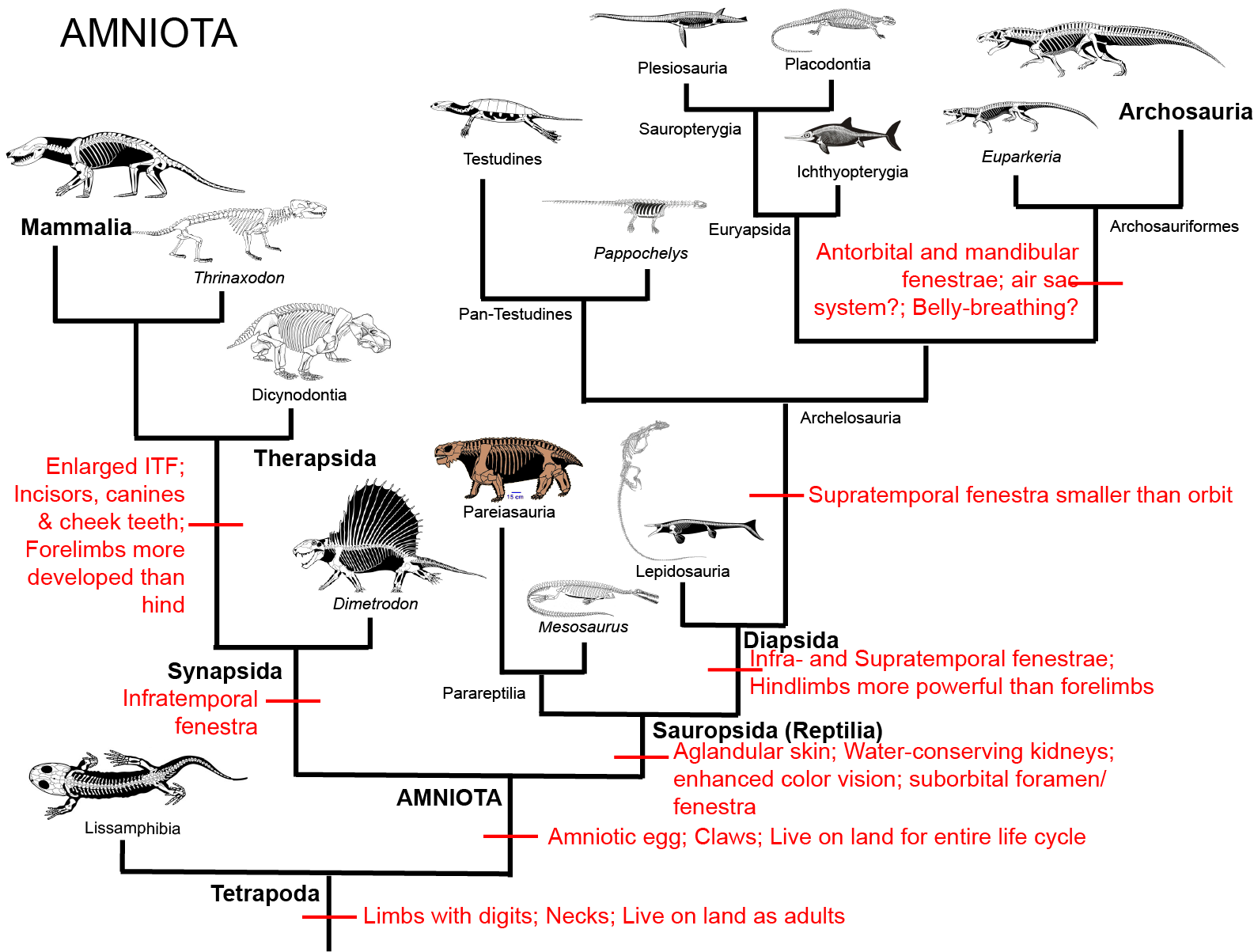
There are two major clades within Amniota. Synapsida includes mammals and all taxa closer to us than to the sauropsids. The synapsids were the first group to radiate, becoming diverse in the Late Carboniferous and Permian. Synapsids are characterized by a skull with a complete infratemporal fenestra with a lowerbar but no supratemporal fenestra.
During the Early Permian Epoch primitive synapsids radiated into many different forms:
These early synapsids would have had the sprawling stance found in primitive tetrapods in general. They almost certainly would have been "cold-blooded" (the ancestral state for vertebrates). So traditionally these animals have been considered "reptiles". However, they lack the shared derived features of reptiles (see below), and are instead simply primitive synapsids. (In traditional taxonomy, these were put in the group "Pelycosauria", but this is a paraphyletic group: all synapsids except for therapsids). New discoveries show that even early synapsids had some parental care.
The early synapsids evolved themselves into extinction: that is, they were replaced in the Middle and Late Permian Epoch by the Therapsida: the advanced synapsids. Once called the "mammal-like reptiles", they are not true reptiles. Instead, they are the advanced branch of the synapsid phylogeny. They differed from earlier synapsids by:
The Middle and Late Permian therapsids included:
Ancestrally, all vertebrates are cold-blooded (warm their bodies primarily using sunlight). However, some evidence suggests that the advanced therapsids of the Late Permian may have had elevated metabolisms (that is, were at least partially warm-blooded):
Additionally, some therapsids seem to have had parental care of the young, keeping them in burrows.
The other great clade of amniote is the Sauropsida (sometimes referred to by the older, but more problematic name "Reptilia"). Sauropsids tended to be relatively rare in the Carboniferous and Permian Periods. Sauropsida is characterized by a number of particular skeletal features (which we aren't going to deal with here, as they are fairly technical). Modern sauropsids (and by inference, their concestor and all of its descendants) share a number of soft-tissue features:
Parareptilia is a major clade of basal sauropsids which flourished alongside the synapsids during the Permian, but became rarer in the Triassic. The most primitive of these groups (the aquatic Mesosauridae) was thought (from 2012 to 2014!) to have an infratemporal fesestra, but this appears to be a mistake. Most other basal parareptiles have the no-fenestra (anapsid) condition, although a few derived ones have a fenestra (lacking the lower bar), which is best thought of as independently derived from synapsids and diapsids. Because most parareptiles had the anapsid condition, they were traditionally called "Anapsida", but now called "Parareptilia" (or sometimes "Proganosauria"). Parareptiles underwent a radiation in the Permian, producing:
For many years it was argued that turtles were a branch of parareptile. And it is true that the oldest known animals more closely related to turtles than any other named group is a wide-bodied Permian form with broad ribs. New discoveries of this animal (Eunotosaurus) and of Triassic proto-turtles show that the turtle lineage is a type of diapsid, however, and not parareptiles at all.
Other primitive Carboniferous and Permian sauropsids show the anapsid condition, but were eureptiles (the clade containing diapsids [see below] and their closest relatives).
Relatively rare during this time are the oldest known members of Diapsida. This would eventually evolve into the major clade of eureptiles, and the dominant clade of amniotes during the Mesozoic. Changes from the ancestral sauropsid condition to Diapsida include:
During the late Paleozoic diapsids were only a very minor part of the ecosystem.
In general, compared to typical Mesozoic and Cenozoic ecosystems, the late Paleozoic land vertebrates were smaller (few ox- or hippo-sized, none larger), slower (no real speed specialists), and close to the ground (only a few gliders and no powered fliers; few tree-climbing specialists).
At the end of the Late Permian, the greatest extinction in the history of life clobbered ecosystems on land and sea. This event totally changed the make-up of the diversity of life, and forms the boundary between the Permian Period of the Paleozoic Era and the Triassic Period of the Mesozoic Era. Consequently, it is called the Permo-Triassic Extinction. Perhaps 95% of all species died out.
The cause seems to ultimately have been the Siberian Traps, a monumentally huge series of volcanic eruptions. These raised global temperatures through extremes of greenhouse gasses; this further triggered additional greenhouse gasses being released from the sea floor. Together, extremes of heat and of carbon dioxide and very low levels of oxygen caused mass deaths.
Regardless of precise scenario, extinction reorganizes the world. In the immediate aftermath, there was a great reduction in size and diversity of the animals present.
Lost were many of the primitive therapsids and many of the primitive reptiles.
During the Early Triassic diversity started off very low in land and sea, and recovered over the next ten million years or so. On land, more advanced carnivorous therapsids were the dominant predators, and piglet to ox-sized herbivorous therapsids were common. But the sauropsids (and especially diapsids) began to radiate into the number of different forms:
Within Archosauromorpha is the clade Archosauriformes, characterized by the antorbital and mandibular fenestra. The former is related to sinuses in the snout; the latter for jaw muscles. Early archosauriforms ranged from cat to cow size. Within the archosauriforms was Archosauria ("ruling reptiles"), the dominant group of Mesozoic sauropsids.
Archosauriforms are also characterized by the "semi-improved" or "semi-erect" posture, so that they could move sometimes without having to twist from side-to-side; by interlocking gastralia that may have worked to help pump extra oxygen through the body: belly-breathing; and possibly by early versions of the air sac system (more about that in the later part of the course)
It is not certain if these early archosauriforms had the behavioral traits found in both the living groups of Archosauria (that is, crocodylians and birds). Because both crocodylians and birds share the following derived traits, however, it is fairly certain that at least the concestor of all Archosauria had them, and passed them on to its descendants:
During the Middle and Late Triassic, the archosaurs displaced the therapsids as the dominant group of large terrestrial amniotes.
Archosaurs are divided into two main branches:
It is the pseudosuchians which dominated the Middle and Late Triassic. This group is characterized by a complex heel-based ankle (the crurotarsal ankle). This group radiated into a number of forms:
The pseudosuchians include some of the first terrestrial animals to exceed the size of oxen and hippos. Most of them could stand with a semi-erect posture of the limbs, and a few had the fully-erect (that is, parasagittal gait).
To Next Lecture.
II. Archosaur Diversity, Past and Present
Simplified cladogram of Archosauria.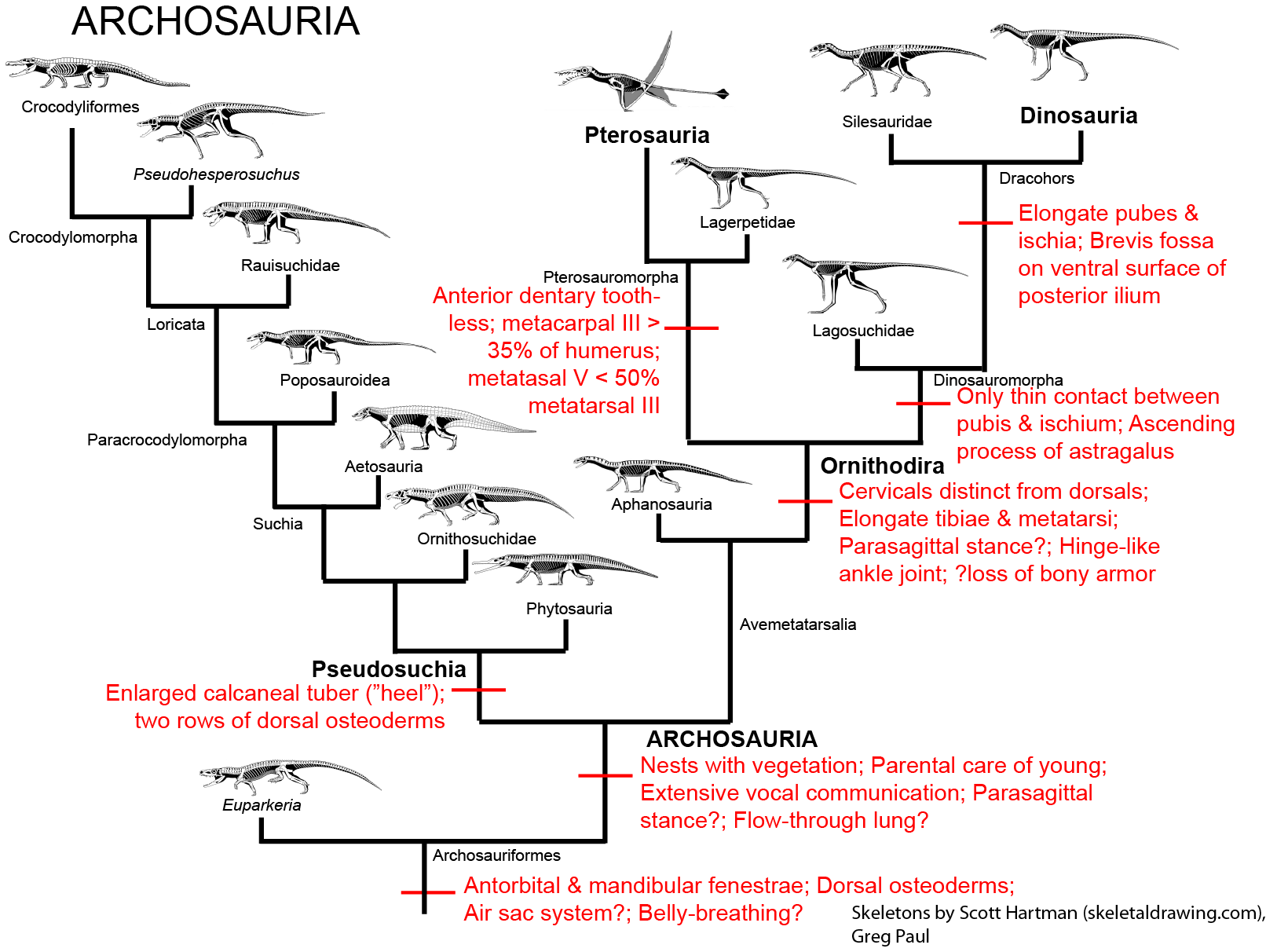
More detailed phylogeny of Avemetatarsalia, with concentration on the early dinosaurs.
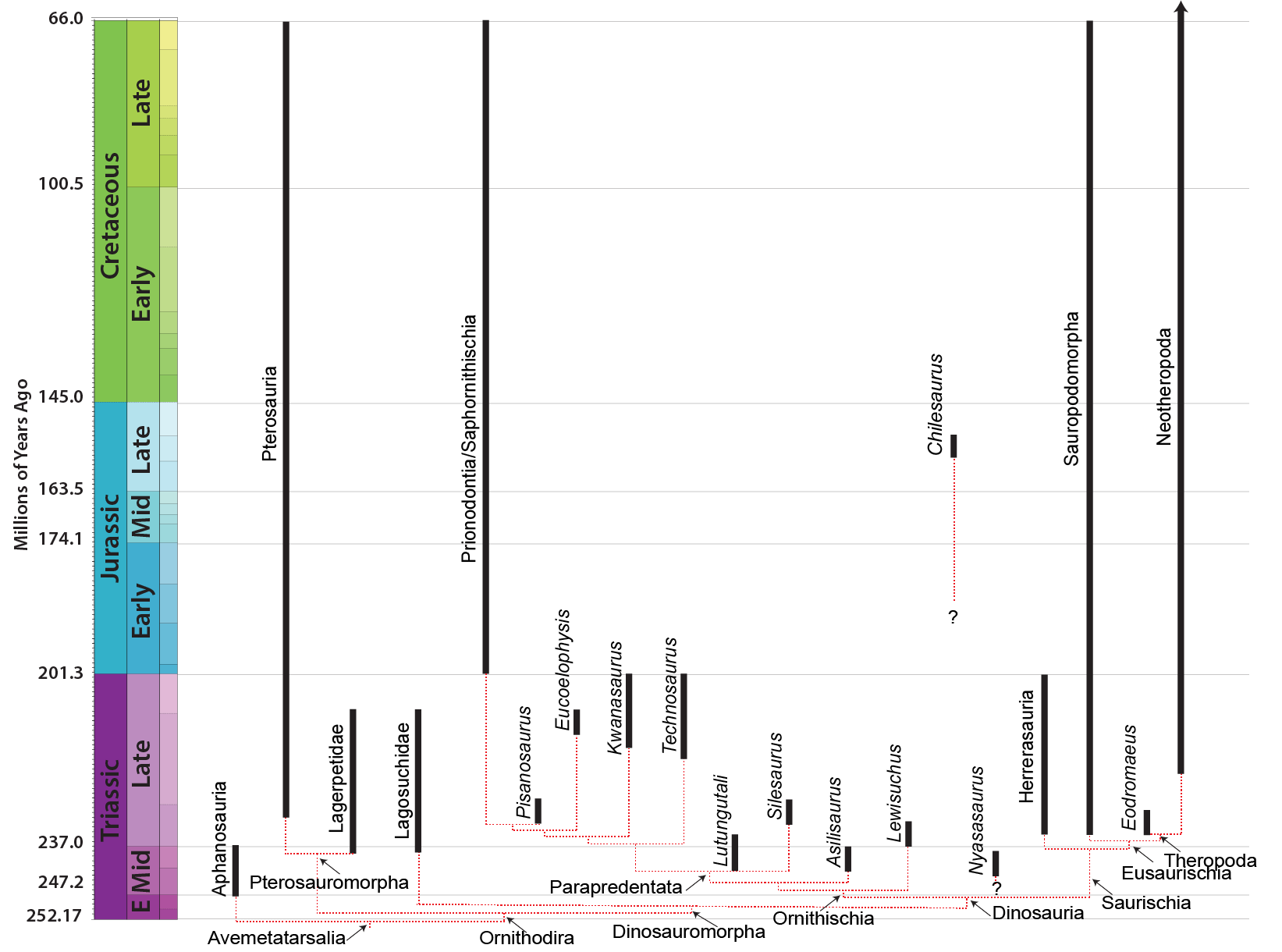
To Previous Lecture.
To Lecture Notes.Last modified: 24 September 2020
